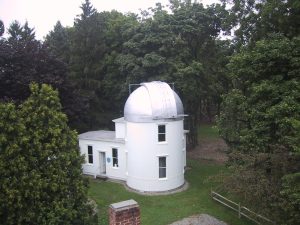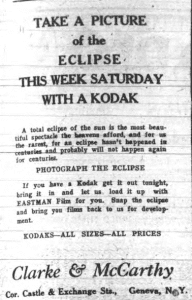1925 Solar Eclipse
On April 8 there will be a total eclipse of the sun and Geneva will be in the path of totality. Over the past 124 years Genevans have experienced a total solar eclipse only two other times – May 28, 1900, and January 24, 1925.
Below are newspaper accounts of the 1925 eclipse.
(The Hobart Herald, February 5, 1925)
Observations Of The Eclipse Unsuccessful
Clouds Obscure Sun at Moment of Totality; Wind Stops Balloon Ascension
The total eclipse of the sun has come, has been seen, and has gone. On the specified morning, the sun rose red and clear, at a little after seven. Above the sun, however, was a bank of clouds, which refused to dissipate under the influence of a southerly wind. On the contrary, they grew thicker, and at the exact moment of the total eclipse, they completely obscured the sun. The partial eclipse, both before and after the moment of totality, could be seen by most of the observers, however. Even though the sun was obscured at the most important moment of all, the period of totality was an awe-inspiring spectacle, which will not be repeated in this section of the earth for three centuries. It gave one a queer feeling to have a deep twilight come over the land in the early morning, shortly after having risen from a nice warm bed to watch it.
All of the observations which were attempted at or near Hobart seemed doomed to fail. The party of scientists from the University of Michigan, who chose Geneva as an advantageous place from which to view the eclipse, were doomed to disappointment by one of our south winds. Professor Hussey, of the University of Michigan, was in charge of the expedition, and Lieutenant Emerson was flight commander. They were accompanied by Judge Hulbert, Mr. Harris, and Mr. Upson. The party arrived with the ballon on Friday afternoon and after much labor succeeded in putting it up at the Coke Works (the Empire Gas and Electric plant in Border City). They were helped materially in this work by a squad of Hobart students. A few men stayed with the balloon over night and early the next morning a squad of twenty-five went over to help finish the inflation. This was completed about 8:30 am. By this time the wind had increased to 35 miles per hour, and kept dragging the balloon to the northern side of the small enclosure where there were some high tension wires. Mr. Upson, being unable to determine the lifting power of the balloon, decided it would be too dangerous to take up the whole party. He offered to go up alone but the rest of the party would not permit it, so the flight was called off. About two minutes later, a strong gust of wind came up and tore a big rent in the side of the balloon, which at once collapsed. In spite of the calamity, the experience was thoroughly interesting to all the Hobart students who were brave enough to get up at four o’clock in the morning.
Another group, under Professor Durfee’s guidance paid a visit to the Brooks Observatory on Castle Heights. The telescope was thoroughly examined, and its operation explained by Miss Brooks (William Brooks’ daughter). Most of the observations were conducted outside of the observatory, but all were unsuccessful owing to the clouds. On the whole, though, even though the observations were disappointing, yet enough was seen by all to make the day memorable.
(Geneva Daily Times, January 24, 1925)
Eclipse Provided Thrills as Darkness Enveloped Earth
How did the eclipse look to Geneva observers?
Presumably there will be just as many descriptions of the phenomenon as there were people to observe it.
It is certain, however, that nobody in the immediate neighborhood of Geneva saw the total shadow of the ellipse and it is equally certain that those people who saw the partial eclipse best were those who selected some elevated vantage point in the downtown section, where they could look out over Seneca Lake.
The first phases of the eclipse were similar to any partial solar eclipse. The shadow of the moon crept slowly – or rather, rapidly – over the face of the sun, a deep intense black that completely obscured that portion of the solar orb. At this period the sun was in plain view and with pieces of smoked glass the increasing shadow could be watched closely.
It looked as though Genevans would be able to see the total phase and general preparations were made. Observers at about quarter of nine settled themselves to wait for the total phase, which was scheduled to arrive at about 9:10.
And then the worst happened. There was a long, low-lying bank of grey clouds hanging over the east and into this the sun slid. At first in the edge of the clouds, the sun’s surface was still visible, a silvery crescent instead of the red ball it had been a few minutes before. Then as the clouds got thicker the sun was entirely blotted out and was not seen again until long after the period of the total phase.
But the eclipse did not pause without providing its thrill. The observers still clung to their reserved seats on the window ledges of high buildings and on the roof tops, waiting for the moment when the earth would be plunged into darkness. And it came at 9:10 as scheduled. Below the cloud banks in the east and far off to the south the sky was lighted with a peculiar yellow-copper light. Suddenly as the shadow of the moon swept down over the earth this light was blotted out and turned to a dark, livid purple with streaks of red and yellow through it. It did not become as dark as night but rather dark as twilight. Lights were turned on in the streets and in buildings. It looked like early evening.
But this was only for a few brief moments. In less than two minutes there was a sudden swish of light off to the south and in an instant the sky in the direction was lighted again and in another instant light was again upon the earth. It had been a thrilling moment but only a moment. And the eclipse will not return for 100 years.
There was some interest in watching the remainder of the eclipse after the total phase had passed but it was some time before the sun again speared through the bank of clouds and for most observers the shadow of the moon was well off the orb before it was again glimpsed. At shortly after ten o’clock there was little, or nothing left of the long heralded and eagerly awaited eclipse of 1925. Science had accurately estimated its appearance and duration, but because of that long, low-lying bank of grey clouds to the east the climax of the spectacle had been ruined for Genevans. And science could do not a thing to remedy it. Thus is Nature wonderful and powerful and sometimes – disappointing.


